#Pilot Plant Solutions
Explore tagged Tumblr posts
Text
"Namibia is the driest country in Sub-Saharan Africa, and home to two of the world’s most ancient deserts, the Kalahari and the Namib. The capital, Windhoek, is sandwiched between them, 400 miles away from the nearest perennial river and more than 300 miles away from the coast. Water is in short supply.
It’s hard to imagine life thriving in Windhoek, yet 477,000 people call it home, and 99 per cent of them have access to drinking water thanks to technology pioneered 55 years ago on the outskirts of the city. Now, some of the world’s biggest cities are embracing this technology as they adapt to the harshest impacts of climate change. But Namibia leads the way.
How did this come about? In the 1950s, Windhoek’s natural resources struggled to cope with a rapidly growing population, and severe water shortages gripped the city. But disaster forced innovation, and in 1968 the Goreangab Water Reclamation Plant in Windhoek became the first place in the world to produce drinking water directly from sewage, a process known as direct potable reuse (DPR).
That may sound revolting, but it’s completely safe. Dr Lucas van Vuuren, who was among those who pioneered Windhoek’s reclamation system, once said that “water should not be judged by its history, but by its quality”. And DPR ensures quality.
This is done using a continuous multi-barrier treatment devised in Windhoek during eight years of pilot studies in the 1960s. This process – which has been upgraded four times since 1968 – eliminates pollutants and safeguards against pathogens by harnessing bacteria to digest the human waste and remove it from the water. This partly mimics what happens when water is recycled in nature, but Windhoek does it all in under 24 hours...
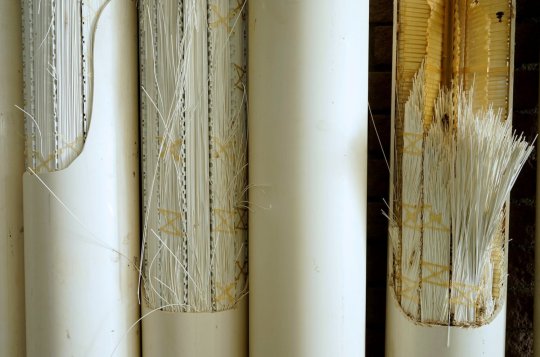
Pictured: These ultrafiltration membranes help to remove bacteria, viruses and pathogens. Image: Margaret Courtney-Clarke
“We know that we have antibiotics in the water, preservatives from cosmetics, anti-corrosion prevention chemicals from the dishwasher,” Honer explains. “We find them and we remove them.”
Honer adds that online instruments monitor the water continuously, and staff ensure that only drinking water that meets World Health Organisation (WHO) guidelines is sent to homes. If any inconsistencies are detected, the plant goes into recycle mode and distribution is halted until correct values are restored.
“The most important rule is, and was, and always will be ‘safety first’,” says Honer. The facility has never been linked to an outbreak of waterborne disease, and now produces up to 5.5m gallons of drinking water every day – up to 35 per cent of the city’s consumption.
Namibians couldn’t survive without it, and as water shortages grip the planet, Windhoek’s insights and experience are more important than ever.
Interest from superpowers across the globe
In recent years, delegations from the US, France, Germany, India, Australia, Singapore, and the United Arab Emirates have visited Windhoek seeking solutions to water shortages in their own countries.
Megadrought conditions have gripped the US since 2001, and the Colorado River – which provides 40 million people with drinking water – has been running at just 50 per cent of its traditional flow. As a result, several states including Texas, California, Arizona and Colorado are beginning to embrace DPR.
Troy Walker is a water reuse practice leader at Hazen and Sawyer, an environmental engineering firm helping Arizona to develop its DPR regulations. He visited Windhoek last year. “It was about being able to see the success of their system, and then looking at some of the technical details and how that might look in a US facility or an Australian facility,” he said. “[Windhoek] has helped drive a lot of discussion in industry. [Innovation] doesn’t all have to come out of California or Texas.”

Pictured: The internal pipes and workings of Namibia's DPR plant. As water becomes scarcer in some parts, countries are looking to DPR for solutions. Image: Margaret Courtney-Clarke
Namibia has also helped overcome the biggest obstacle to DPR – public acceptance. Disgust is a powerful emotion, and sensationalist ‘toilet to tap’ headlines have dismantled support for water reuse projects in the past. Unfortunately, DPR’s biggest strength is also its biggest weakness, as the speed at which water can re-enter the system makes it especially vulnerable to prejudice, causing regulators to hesitate. “Technology has never been the reason why these projects don’t get built – it’s always public or political opposition,” says Patsy Tennyson, vice president of Katz and Associates, an American firm that specialises in public outreach and communications.
That’s why just a handful of facilities worldwide are currently doing DPR, with Windhoek standing alongside smaller schemes in the Philippines, South Africa and a hybrid facility in Big Spring, Texas. But that’s all changing. Drought and increased water scarcity worldwide are forcing us to change the way we think about water.
Now, the US is ready to take the plunge, and in 2025, El Paso Water will begin operating the first ‘direct to distribution’ DPR facility in North America, turning up to 10m gallons of wasterwater per day into purified drinking water – twice as much as Windhoek. San Diego, Los Angeles, California, as well as Phoenix, Arizona are also exploring the technology."
Of course, DPR is not a silver bullet in the fight against climate change. It cannot create water out of thin air, and it will not facilitate endless growth. But it does help cities become more climate resilient by reducing their reliance on natural sources, such as the Colorado River.
As other nations follow in Namibia’s footsteps, Windhoek may no longer take the lead after almost six decades in front.
“But Windhoek was the first,” Honer reminds me. “No one can take that away.”"
-via Positive.News, August 30, 2023
#namibia#africa#desert#water shortage#water conservation#dpr#potable water#water recycling#clean water#drought#united states#colorado river#science and technology#sanitation#good news#hope
2K notes
·
View notes
Text

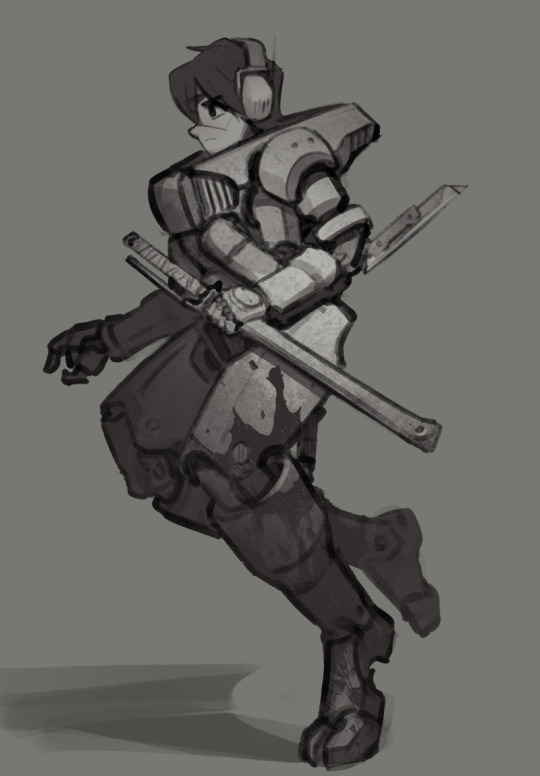


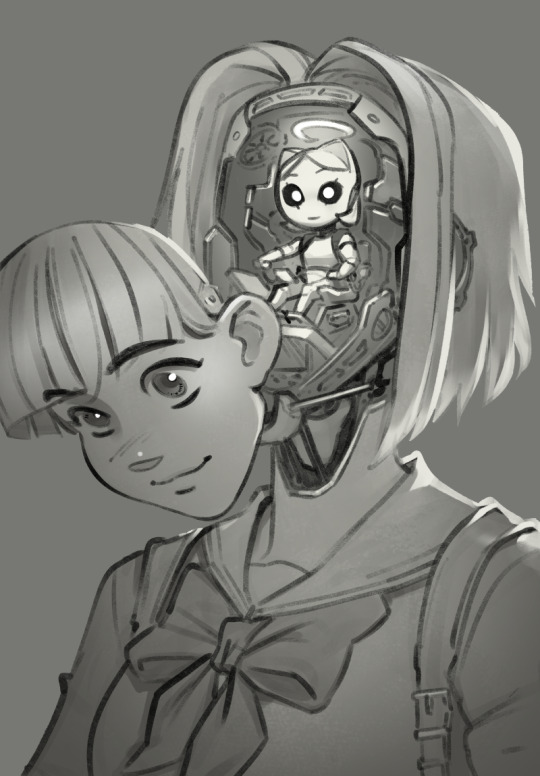
I've been continuing my quest to draw 100 different characters, once a day every weekday and a couple weeks ago was like... "Girls and Mecha" week. And I tried each time to have like... a different take on the theme but would still have certain similar aesthetics. With the exception of the "school girl" the other machines were inspired more with industrial or construction machines.
So like... here's a power loader type mech. And a power armor type design. Then there was like... a mecha pilot but all she got was a roomba. Then there was the "pilot" and there was the girl that is actually the mech for a tiny robot. Was fun!
I had this whole lore where it was some corporation fighting some future union rebels on some space planet. Maybe I'll expand more on that someday.
EDIT: It occurs to me I should probably include the flavor text from when I tweeted these out. I'll put them in the same order as the images here:
"You know Kimmie, from the loading docks? Yeah she took to the Pile Bunker like a champ. You should see her tear open the corpo APCs."
2. "The off world colony workers repurposed the excavator suits into mobile armor frames. Corporate needs you to shut this down, now."
3. "The workers at the BIG PLANT found a little creative solution for taking their work with them while moving through and monitoring the factory floor. They've taken to personalizing their "Desk-bas" thinking of them like their own little mecha."
4. "The Cortex Walker, inspired by some particularly cruel science fiction, was Corporate's latest attempt to demoralize the rebel factions. While impractical from a mechanical perspective, the psychological impact of firing on captured allies could not be understated."
5. "My Best Friend is An Alien (and Unfortunately That's my Type!)"
3K notes
·
View notes
Text
Good News - August 1-7
Like these weekly compilations? Tip me at $kaybarr1735 or check out my new(ly repurposed) Patreon!
1. Zoo hails birth of 'one of world's rarest animals'

“[Jasper] the Persian onager was born to mum Azita after a year-long pregnancy. […] Conservationists at the zoo said there are less than 600 surviving wild onagers[, … which] only survive in two small, protected areas in Iran, a Chester Zoo spokesman said. […] Mike Jordan, animal and plant director at Chester Zoo, […] said Jasper is "doing very well" and added that "mum Azita is doing a fantastic job of nurturing and bonding with her new charge". "He’s full of energy and enjoys playfully kicking up sand as he races around his habitat", Mr Jordan added.”
2. Charity creates 50 community orchards in city

“Community orchards are returning to Birmingham, with the aim of teaching people how to grow their own food and be part of the solution to climate change. […] Once established, the long-term aim is to distribute the produce to those most in need, but local people are also invited to pick the odd bit of fruit. […] By planting trees and plants and encouraging biodiversity back to these areas the charity is also doing its bit to help climate change. They even use locally sourced wood chip which helps to put carbon back into the soil. […T]he hope is that these edible landscapes can also be enjoyed by local people for years to come.”
3. Farmer-led badger vaccination could revolutionize mission to tackle bovine TB

“[… T]he results of a four-year pilot badger vaccination program co-managed between farmers, scientists, and conservationists […] show the percentage of badgers testing positive for bovine tuberculosis (bTB) in the study area dropped from 16% to 0%[….] While most bTB incidents in cattle are caused by transmission between herds, transmission from wild badgers plays a role in the persistence of the disease. […] Blood sampling showed that the proportion of badgers with bTB fell even though overall badger numbers remained high[….]”
4. Every Colorado Anti-Trans Ballot Initiative Fails To Collect Enough Signatures

“Anti-transgender politics are becoming increasingly unpopular in polls. […] A recent LA Times/NORC poll found that 77% of voters believe elected officials use transgender debates to divert attention from more pressing issues. The poll also showed significant opposition to forced outing policies. […] A Gallup poll published in June revealed that while Americans have mixed views on the morality of transitioning, the majority oppose bans on gender-affirming care for trans youth. […] “The fact that they could not get enough signatures, barely half, to be placed on the ballot shows they lack support from everyday voters.”
5. In a fight to save a rare bird, Indigenous communities in Guyana are winning

“The partnership [between Indigenous communities and Smithsonian researchers] sparked a decades-long community-led conservation movement that has protected the red siskin and helped locals reconnect with nature. [… T]he South Rupununi Conservation Society […] established one of the country’s first conservation zones to protect the species, covering 75,000 hectares (185,000 acres) of Indigenous land. […] To plant the seeds of conservation, they’ve implemented an after-school program in more than 16 communities, [introducing children] to ecological research and surveying, and also [teaching] about Indigenous culture and tradition, including fire management skills.”
6. North Adams hospital gets federal designation which pays for health care in rural areas

“[The hospital] received a federal designation on Wednesday that is key to its long-term financial stability. […] The designation pays for staffing regardless of the number of patients[… and] “works to resolve stark inequities in rural and underserved communities as it relates to our nation’s health system."”
7. Andrea Vidaurre: Leading the clean transportation revolution
“Thanks to Vidaurre’s relentless advocacy and strong community support, these regulations introduced the first national standards for train emissions and set a groundbreaking goal for all freight trucks to be zero-emission by 2036. This initiative promises cleaner air for Californians and paves the way for a zero-emission vehicle future across the country. Studies predict these measures will prevent thousands of respiratory illnesses and save countless lives in the coming decades.”
8. Boston announces a new climate resilience office

“Through its Climate Ready Boston initiative, the city has worked to […] design creative adaptation plans with community input[, …] includ[ing] everything from redesigning waterfront parks and planting more trees, to modernizing the city’s underground sewer system[….] The Office of Climate Resilience will be in charge of coordinating work across city departments and with community groups[….]”
9. Combining Green Thumbs and Sustainable Fashion in a Swap Event

“This unique plant and clothing swap event in NSW is championing both environmental and fashion sustainability through native plants and preloved clothing. […] To participate in the plant swap, attendees brought their environmental weeds in a bag to the Council stall and exchanged them for free native plants. […] The event sparked valuable community conversations about the benefits of plant and clothes swaps, the impact of textile waste[, …] support a circular economy and combine a love for nature with practical, eco-friendly practices.”
10. Growing Green Spaces to Protect the Endangered Regent Parrot

“On Schools Tree Day, celebrated on 26 July, students from a local NSW school planted trees and shrubs to create crucial forage habitat for the endangered Regent Parrot, enhancing local biodiversity. […] Approximately 50 [… plants of] native species were chosen for their ecological benefits, helping to attract native birds, bees and butterflies while providing essential habitat and food. […] They [also] raise awareness about the regent parrot, encourage conservation efforts and emphasise the importance of protecting local wildlife. Additionally, conserving [the regent parrot] supports the health of their ecosystem by helping with in [sic] seed dispersal and maintaining plant diversity.”
July 22-28 news here | (all credit for images and written material can be found at the source linked; I don’t claim credit for anything but curating.)
#hopepunk#good news#zoo#donkey#orchard#community#food insecurity#community garden#badger#vaccine#cow#tuberculosis#colorado#trans#transphobia#transgender#law#politics#birds#indigenous#conservation#hospital#health#healthcare#california#trains#truck#zero emissions#climate change#boston
52 notes
·
View notes
Text
Heero Yuy: Does Not And Has Never Known What Is Going On
Pilot Spice Rating: | 🌶🌶🌶🌶🌶|
I need everyone here to understand one extremely important thing: Heero Yuy does not think.
Heero Yuy reacts. He reacts instantly to stimuli because he is not thinking. This leads a lot of people to believe he’s some kind of savant, but in fact he is purposefully, intentionally, not having thoughts. He does not calculate his actions based on any consequences beyond the necessary outcome. Sometimes, this gets him into trouble. But mostly, it keeps him alive.
And let’s be clear: it's not because he can't think ahead. Not thinking about things is his primary self-defense mechanism; this is a deeply traumatized child soldier, who lives in perpetual hyper-awareness of his own expendability. He is never thinking about tomorrow, because he might be dead before then.
So why does he know how to do so many things? He really doesn’t. If it looks like he knows what he’s doing, it’s because he’s failing so nonchalantly that it looks like confidence. People are constantly doing the work for him by assuming he’s ultra-competent at everything he does. Heero is a cipher that everyone projects their ideas and feelings onto.
He was trained at a young age to assimilate himself into new environments through observation and imitation– which he’s very good at, so he doesn’t HAVE to know things. If he needs to learn something new, he can pick it up fast on the fly, or just make whatever it is work by brute force.
If you see a nail and you don’t have a hammer: get creative.

Okay, but how come he always seems to know exactly what’s going on? He has a smart guy in his ear telling him what to do. Later, he has an insidious AI program in his ear telling him what to do. And the rest of the time he is literally winging it (pun intended) and hoping things will turn out okay if he just keeps at it long enough.
Really, Heero doesn’t need to know what’s going on, and he only needs to be good at ONE thing, which is his solution to everything: keep going.
When he doesn’t have a clear mission objective, he is following his motto: ��do what your heart tells you” / “act on your emotions”-- which is way, way less whimsical and than it sounds (see this entry in the Dictionary section). It’s an extension of the Unthinking: You encounter a problem, you find a solution. Does this feel right? If yes, proceed. If no, then don’t. Was it the wrong solution? Well, that’s a new problem.
If you’re Heero’s problem, you have a very limited window of opportunity to change his mind about it. If you’re Relena, you get another chance. If you’re Marshal Noventa, you don’t. If you’re a fellow Gundam pilot, you might be able to hold him off long enough for the problem to become a different problem.
Heero was built from the ground up several times by the people who found him and turned him into what he is: a weapon that you aim and fire. That’s how he thinks of himself, as a machine with a single purpose that you input instructions into, and when he stops working at peak performance, he’ll die and be replaced.
But the people who were there for his “training” know that there was a human boy underneath that they buried to make their perfect soldier. Sometimes, you can still see him through the cracks.
There are only a few times in canon when we see Heero laugh or smile; I found it a very interesting case study to track when and where he does so. In chronological order, the first time is in a flashback from Endless Waltz; it’s a very memorable scene, because it’s the most innocent and carefree we ever see him, but the thing he was doing directly before flopping onto the grass and laughing wholesomely was planting explosives in a military base. The outcome of this scene is a defining tragedy of his life, which we know was the cause of his needing to be “retrained”.
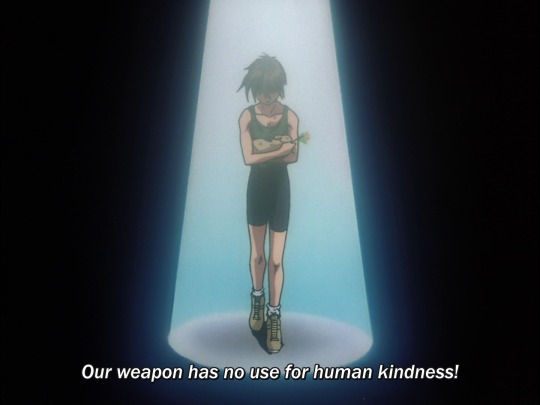
The other few times he laughs are sometime after this incident, when he first arrives on Earth.
In episode one, we get to see him smile and laugh. The smile is one of simple relief, because he’s completed his objective– but what he actually considers that objective to be is a bit complicated. The simplest answer is that he’s successfully made it from the Colonies to Earth, so he can start his mission as a resistance fighter, but the more relevant answer is that arriving on Earth has the potential to be his FINAL mission as the person who stole the Gundam in order to interrupt Operation Meteor. The smile is either because he’s made it past the first difficult step of his journey, or because this is where his journey can finally end.
In this same episode, he laughs after making his first kill; hapless OZ pilots who had no idea what they were up against. Later on, he laughs because he completes a mission after repairing his Wing Gundam with the cannibalized parts of Duo’s Gundam, Deathscythe. Another time, he smiles with an aloof assurance that he does not need to participate in the frivolities of civilian life, as if he’s confirming to himself that he is not like the people he is infiltrating. He’s a robot, disguised as one of them. He doesn’t need to worry about understanding them, or sympathizing with them, or trying to form emotional connections that he isn’t capable of making. He smiles when he cuts down what he thinks is an OZ carrier leaving New Edwards Base.
These are all times when Heero feels like he’s gotten away with something; when he’s pulled off something sneaky and gotten away scot free. It’s a cathartic release of excitement that's a touch mischievous; the surviving traces of his adolescence bubbling up and escaping containment.
Heero doesn’t laugh again after his first failed mission at New Edwards. Even when he cracks a joke, even when he's relaxed, his face remains frozen. There's only one more time when he smiles: when he’s sure he’s on his last mission, the one he won’t come back from, and he knows he has someone he wants to protect.

It is such a simple, kind, naive thing that lets Heero unlock the capacity to feel; he’s never had someone be on his side before. Just… decide that they care about him, for no reason in particular– indeed, after he’d given them ample reason NOT to. It’s not perfect, not a clean process, not all at once. He gets feelings back one at a time, in broken pieces that are sharp and don’t make sense at first. A girl who he thought he would have to kill decided that she would trust him absolutely and have his back no matter what, and that made everything uncertain.
It’s more complicated to live with danger when there’s something to live for, when someone insists that you’re worth saving. It means you have to think about the future sometimes, and that means dealing with consequences, and disappointment, and worry, and pain. It means having to develop a sense of compassion, without which it would be so easy to just turn off, and listen to the comforting absolutes of a machine that tells you how to win and who to kill.
Having something, someone, to lose is frightening– but it gives you a fixed point in the sky to follow, so when you’re facing down ultimatums, and sacrifices, and uncertainty, “winning” becomes less important than keeping who you care about safe.
It makes your heart a much better compass to follow.

160 notes
·
View notes
Text
A Cascading Fix
The floating garbage patch in the Pacific Ocean a huge ongoing issue. Plastic is the worst offender (and no it’s not all drinking straws and plastic bags— it’s mostly discarded fishing nets). Skimming would be too costly and unrealistic (it’s country sized— big country). Plus is almost a biome at this point— you couldn’t scoop out the trash without also scooping animals/eggs/plants basically causing more havoc trying to clean it up.
So what do you turn to? Bacteria
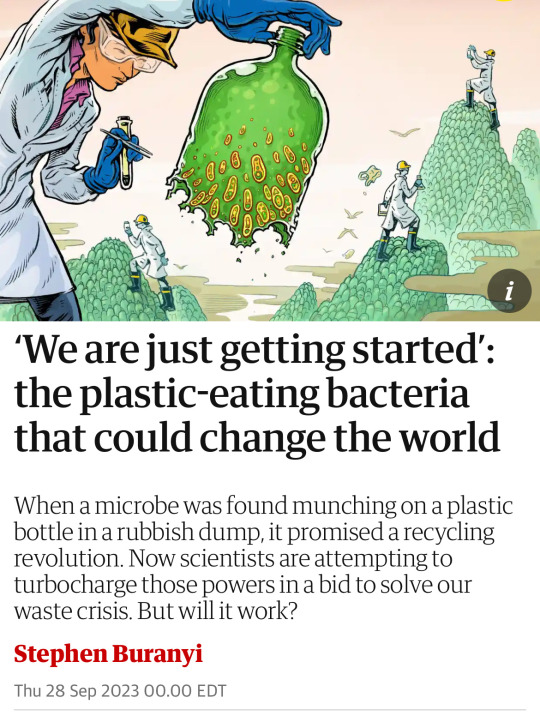

So this area has been in active research for 25+ years as the ultimate solution to dealing with plastic waste.

Should be great right? The lifespan of a bottle in a landfill falls from centuries to weeks in a vat. It’s such an alluring goal that people gloss over the path
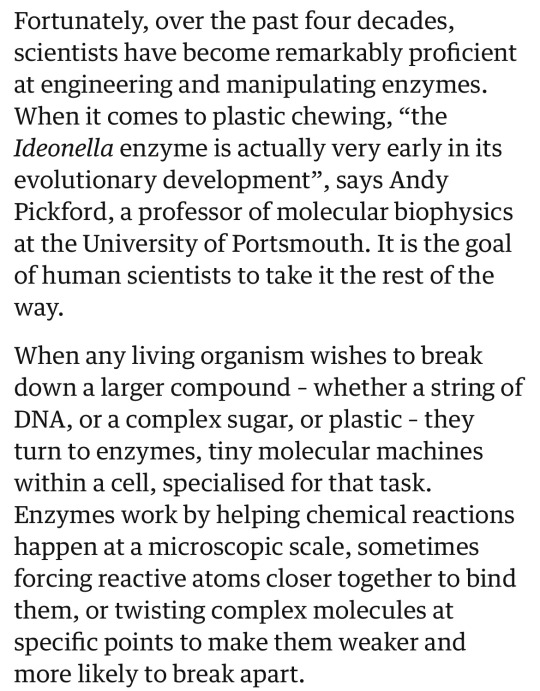

Brute forcing thousands upon thousands of mutations on an enzyme that specializes in breaking down hydrocarbons sounds wildly risky.
Because what if you get one that does too well?
Future Forecaste
Silicon Valley Tech Bro Billion wants to try and improve his image as a part of the private jet class by holding a big public competition for innovative solutions for the garbage patch. Encourages all of his tech bro buddies to pitch their ideas. Billionaire promises to fund a pilot project for the top idea.
What wins out? Bacteria
And they apply the Facebook ‘move fast and break things’ philosophy to brute forcing mutations. Garbage patch is in international waters, so no approval (or oversight) to go and test your ideas.
In fact, with being out in the middle of the ocean, you can build your lab right on a boat and sail out there. And test your iterations right there. In the ocean. Why test on a simulated garbage patch when the real one is right there?
Success! A strain that breaks down plastics in a short timeframe in the cold of the ocean! Your test site quickly goes from floating landfill to. something?
The enzymes broke the plastic into component nutrients. So you now have effectively dumped a whole flood of nutrients into the water. Kinda like dumping fertilizer
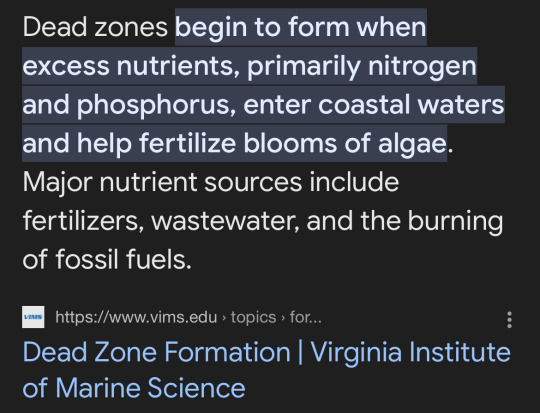
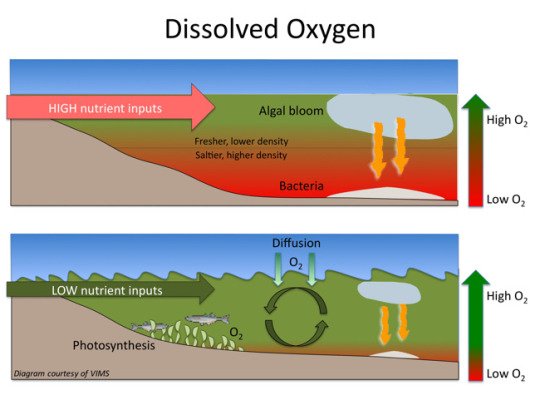
Cool. So now you you have turned garbage patch into the Great Pacific Algal Bloom and Dead Zone
And the bacteria isn’t staying put. Oceans have a way of moving things, and you just built a hardy sailor with a plentiful food supply.
The bacteria makes it to shore and suddenly, plastic isn’t permanent. Plastic isn’t safe in water. Every seal and gasket is now prone to failure. There is a rush to figure out which types of plastics are susceptible, which are resistant. New plastics with bacteria resistance are developed.
But that’s not even going to be the biggest issue
We’ve Got a Fuel Pox on our Hands
If it likes to eat plastic know what it’ll love? Gasoline and any other hydrocarbon
This bacteria would essentially turn gas into soy sauce. Think about fuel rotting
Suddenly world’s energy supply is at risk. Fear of contamination becomes the oil and gas industry’s number one concern. Gas becomes an even more precious commodity, and is only used when application demands. The industry takes on surgical level of cleanliness.
Meanwhile other people are prepping ‘Kombucha’ for their local pipeline
56 notes
·
View notes
Text
When orange bins marked for “compost” drop-off first started proliferating on the streets of New York in February as part of a department of sanitation pilot, many residents celebrated. I was one of them: even as an environmental reporter who has visited the landfill where my trash ends up and is well aware of the problems with food waste, the lack of convenient composting options near me was often prohibitive. Having a bin within walking distance I could access at any time meant all my food waste would finally be converted back into soil.
Or at least that’s what I thought it meant, until the news broke in April that the contents of those “compost” bins mostly don’t go to compost sites, but to an anaerobic digester at a wastewater treatment plant called Newtown Creek. There, the food waste is mixed into sewage before being converted partially into methane.
I wasn’t sure what to make of this, and neither were my neighbors, given that methane is a potent greenhouse gas playing a role in the climate crisis.
Questions about anaerobic digestion – touted as a green solution to food waste – are becoming relevant in more and more places as this method is increasingly a part of organic waste management plans across the US, with plants operating or being built everywhere from Ohio to California and embraced by brands such as Ben & Jerry’s. It’s also fairly common in parts of Europe. But how do its environmental credentials stack up against composting?
54 notes
·
View notes
Text

USAF's NGAD program will receive US$ 3.4 billion in the 2025 budget
Fernando Valduga By Fernando Valduga 13/03/2024 - 18:43in Military
The U.S. Department of the Air Force released a 2025 fiscal budget request of $217.5 billion on March 11, which includes $3.4 billion for the Next Generation Air Dominance (NGAD) family of systems to increase current and future platforms in highly contested environments.
Related to the NGAD is an investment of 14.9 billion dollars to maintain lethality in the air domain, in addition to 24.9 billion dollars to ensure the ability to carry out a global attack worldwide.
The budget requested for the NGAD project to develop an aircraft system to replace the F-22 airfield fighter was $1.6 billion in fiscal year 2023.

Air Force Secretary Frank Kendall declared in 2022 to the House Armed Services Committee that the U.S. Air Force expects to spend “several hundred millions” of dollars per aircraft (of the NGAD system).
The U.S. Air Force previously mentioned that it plans to grant the contract to build the NGAD fighter sometime in 2024 and carry out the development of the project by 2030.
Although no contractor or contractors have been identified, Lockheed Martin, Boeing, Textron and General Atomics could be likely suppliers.
One of the objectives of the NGAD project is to divide the design, production and maintenance contracts to involve a variety of companies to work in the NGAD.
In February 2024, Pratt & Whitney conducted an evaluation of its next-generation adaptive propulsion (NGAP) solution, advancing the program to finalize the detailed review of the project. NGAP intends to progress in the production of an energy plant for the NGAD game.
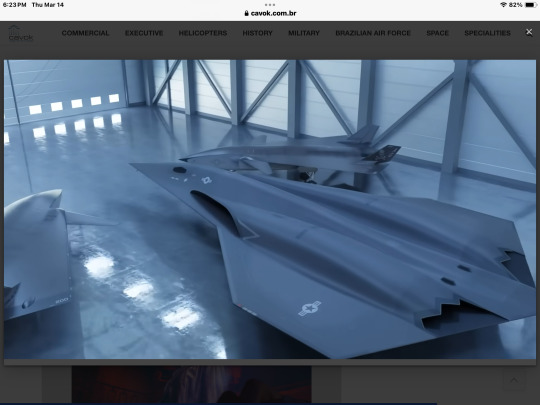
Pratt & Whitney, General Electric, Lockheed Martin, Boeing and Northrop Grumman each received a ten-year contract worth $975 million for the NGAP program in August 2022.
The sixth-generation NGAD fighter will work in partnership with mission-focused unmanned platforms, working with advanced weapons, electronic warfare systems and sensors to ensure maximum survivability in contested environments.
Tags: Military AviationNGADUSAF - United States Air Force / U.S. Air Force
Sharing
tweet
Fernando Valduga
Fernando Valduga
Aviation photographer and pilot since 1992, he has participated in several events and air operations, such as Cruzex, AirVenture, Dayton Airshow and FIDAE. He has works published in specialized aviation magazines in Brazil and abroad. He uses Canon equipment during his photographic work in the world of aviation.
Related news
MILITARY
Taiwan acquires additional MQ-9B SkyGuardian drones from the US
13/03/2024 - 18:18
HELICOPTERS
Bell receives contract to manufacture the AH-1Z attack helicopters for Nigeria
13/03/2024 - 16:00
ARMAMENTS
US approves sale of JASSM-ER, AMRAAM and Sidewinder missiles to Poland
13/03/2024 - 14:00
MILITARY
Italian manufacturer Leonardo presents its business plan for the next five years
13/03/2024 - 10:00
MILITARY
NORAD head said Chinese aircraft may start operating near the US this year
13/03/2024 - 09:00
MILITARY
Denmark prepares for delays in the delivery of F-35 fighters and seeks alternatives
13/03/2024 - 08:15
7 notes
·
View notes
Text
Empowering Africa’s Future Leaders: The Transformative Impact of the JAP Scholarship Program

In Africa, a generation of young, ambitious minds envisions a brighter future, one shaped by innovation, leadership, and resilience. Yet, for many students, the path to higher education and opportunity remains blocked by financial and logistical barriers. The Joint Africa Network (JAN) Scholarship Program, previously known as the JAP Scholarship, is working to break down these barriers, empowering Africa’s future leaders and changemakers.
JAN Scholarship was founded on a mission: to provide talented African students with the resources, mentorship, and education necessary to not only excel in their careers but also to positively impact their communities. It’s not just about funding education; it’s about creating a foundation for long-term growth and leadership. The scholarship covers tuition, living expenses, and other essential costs for students to pursue higher education in fields that are critical for Africa’s development, such as engineering, medicine, and environmental science.
One of JAN’s core strengths lies in its commitment to supporting students’ holistic development. JAN scholars gain access to a network of mentors and professionals from across Africa and beyond. Through workshops, internships, and networking events, JAN ensures that students not only grow academically but also develop key skills in leadership, problem-solving, and collaboration. Each JAN scholar returns home equipped with the expertise and confidence to tackle some of Africa’s most pressing challenges.
Amina, a JAN scholarship recipient from Kenya, dreamed of becoming a doctor but faced financial hurdles. With the support of the JAN Scholarship Program, she is now studying medicine and leading a telemedicine project aimed at connecting rural communities to accessible healthcare. Amina’s story highlights JAN’s approach, supporting students with dreams that go beyond personal success to have a positive impact on society.
Similarly, Kofi, an engineering student from Nigeria, received JAN’s backing to attend a leading European university. Passionate about renewable energy, he’s designing a solar panel system specifically for rural African homes. JAN’s support helped turn Kofi’s vision into a pilot project that is already bringing clean energy to communities in need.
The JAN Scholarship Program’s approach ensures that these students aren’t just scholars; they are future leaders equipped to address Africa’s needs. Each graduate becomes a beacon of progress in their communities, inspiring others and creating solutions tailored to the unique challenges of their regions.
The impact of the JAN Scholarship Program stretches beyond individual students. By supporting Africa’s brilliant minds, JAN is planting seeds for a future where Africa’s own leaders, innovators, and changemakers drive sustainable growth and transformation across the continent. Through its scholarship and mentorship, JAN is helping to build an empowered, self-reliant Africa, one future leader at a time.
#business#entrepreneur#entreprenuership#pr agency#pr firm#fully funded scholarships#public relations#startup#small business#education#educate yourself#opportunity
2 notes
·
View notes
Text
Stargate rewatch: 1x21 Within the Serpent's Grasp

We’re back in tarp city, quite a circle back to the pilot.
Daniel sans glasses once again, urging the team to go through the gate to the address he got in the AU. Jack still doesn’t believe him and Sam is concerned about a court martial, but Teal’c is immediately on board.
“In the other reality by the time I left Sara was dead, Carter your whole family was dead, hell I was dead, everyone was dead.” Interesting that Daniel specifically mentions Sara here, I wonder if the Jack/Sara relationship was something they were considering revisiting at some point.
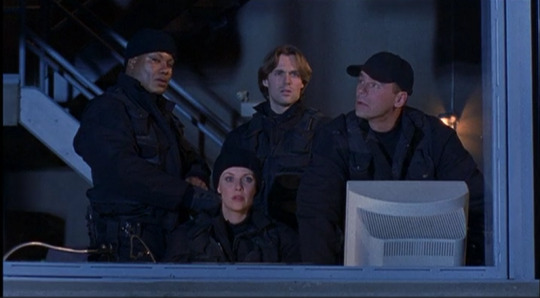
The first use (I think) of the black BDUs by the team.
Is Daniel wearing contacts? At least in the earlier scene he had his glasses hooked on his shirt. I realise I’m harping on this but there doesn’t seem to be any continuity to Daniel’s vision.
Story by James Crocker (his only Stargate credit), teleplay by Jonathan Glassner, directed by David Warry-Smith.
Our first use of the Zat’nik’tel - unpopular opinion maybe but I love the Zats, they become somewhat of a crutch as an all purpose stun gun rather than the “extreme pain” they’re introduced as inflicting, but that’s how it goes.
Jack, Daniel, and Sam being floored by the ship accelerating but not Teal’c is a nice touch.

It’s Ferretti! Confirmation that he took over from Kawalsky leading SG-2. I always liked Ferretti, it’s a shame he wasn’t more of a supporting/recurring character in the show. In fact I don’t think we see him again after this episode? He’s off to get into prosthetics on Andromeda.
Some continuity issues with what Teal’c knows about the Ha’tak vessels in this episode compared to later on - his knowledge/experience really is dictated by the episode requirements.
The Jaffa turn on the big ol’ silver ball of communication and Apophis dials in to introduce his son Klorel. It’s a bit of a retcon from the pilot but I discuss my headcanon explanation in that episode writeup.
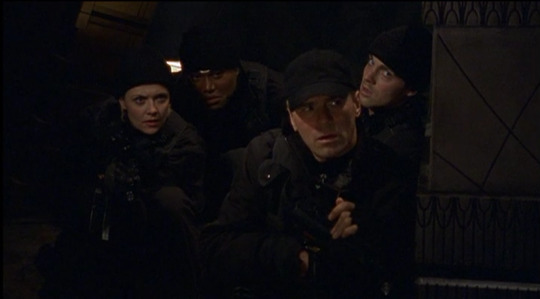
Daniel shifting into rage mode at seeing Apophis.
Also lol at everyone in their beanies but Jack. RDA really said nope, caps only for O’Neill, no exceptions.
The discussion the team has about whether to try and capture Klorel/rescue Skarra is actually a nice mirror of the one they have in The Nox - Jack and Daniel, being emotionally invested, are keen to do it despite the risk and are quick with justifications (Jack - it would be a strategic advantage, Daniel - they could try and reach Skaara), Teal’c supports them with his own tactical logic, while Sam appropriately questions the plan and makes sure there’s a contingency.
It’s part of why they make such a good team - each of them bring a different skillset and pov to each situation, and they have the respect for each other to talk it through.

Sam and Daniel plant the C4, and apparently Daniel’s glasses were clipped to his shirt after all, because he takes them out and puts them in a vest pocket for some reason.
For Daniel's snark about "uploading a virus to the mothership" the previous episode, it's kind of lol that their solution ends up being just blowing up the mothership - uploading a virus in the form of explosives.
Jack and Teal’c actually nab Klorel pretty easily in the end - it’s holding onto him that’s the problem.
“He is my father. He seeded the queen mother. He chose the host in which I will live out eternity. Apophis gave me life.” I suppose we’re meant to assume Amaunet is the queen in question but I really wish they’d done more with the familial relationships - both of the Goa’uld and human sides.
Alexis Cruz gives a great performance as Klorel, really pushing Jack’s buttons.

After Jack shoots him with the Zat, Skaara calls for both Sha’re and Daniel 🥺
Skaara is able to maintain a degree of influence over Klorel even when he regains control - afteraffects of the zat, Skaara’s strength, or because Klorel is a young Goa’uld not yet experienced in controlling a host? Perhaps all three.
Klorel gets Daniel in the hold of the ribbon device (but of course!), and Jack has to make the agonising decision to shoot Skaara to save Daniel’s life.
I mean, if I had a nickel every time a member of SG-1 has to shoot one of Daniel’s family to stop the Goa’uld that possesses them from killing him with the ribbon device…
Maybe it’s not that weird it happened twice, since Jonathan Glassner also wrote Forever in a Day.
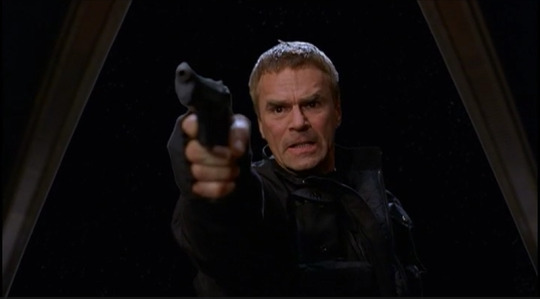
“O’Neill, you must take action!” Why doesn’t Teal’c take action? Someone run over there and tackle Klorel instead of standing around watching Daniel’s brain get fried!
But of course it has to be Jack - Jack who brushed by Daniel in the pilot to greet Skaara, but has grown closer to Daniel since he joined SG-1; they started out only united by a common goal (find Sha’re and Skaara) but have started to develop a real bond. It’s the emotional climax not only of the episode, but the whole season in forcing Jack to chose between the lives of his surrogate son and his comrade and friend.
Added to this is the trauma of Jack being forced to stop Skaara with a gun - Charlie died in part due to Jack’s negligence around his gun, but Jack actively had to shoot Skaara here and that’s heartbreaking.

A nice mirror to the end of the last episode, with our team staring down at the Stargate framed by the control room of the SGC, and now they're staring down at Earth framed by the Pel'Tak.
9 notes
·
View notes
Text
Major Armored Core 6 spoilers (Liberator. If you don't know what that means don't click read more)
God damn the ending that I got for Armored Core 6 kinda hurts my heart. I dunno how "customizable" the endings are (like if you can reach the same end through different means, i.e. killing less people, changing your mind at the last second, etc.) but 621 ended up getting nearly everyone who ever showed them any love or care killed or ruined their dreams.
Walter? Last second, 621 decided to ignore any kind of lineage Walter wanted to create in them to ensure the destruction of the Coral. In fact, they killed him with their own hands. Or rather their own AC.
Carla? Knowingly betrayed her in her last stand against Arquebus and brought down her half-century-old supercity colony ship.
The once-welcoming teams of AC pilots (the Vespers and Redguns) are both disbanded and most of their members meet their ends. Even if 621 *didn't* decide to kill Michigan on their own, he was fated to die. Rusty would have beat him.
Speaking of Rusty, the battle on the Xylem airship was so intense that he had to run off on his own to hold up an ENTIRE Arquebus fleet of warships, solo. Naturally, despite how impressively long he held out for, he gets shot down.
You could even argue that Ayre was left in the dust a bit. Sure, 621 spared the Vascular Plant and, by extension, the Coral, from being destroyed, but the battle on the Xylem didn't *destroy* Arquebus or anything (or, it shouldn't have. Xylem isn't THAT big). The corporation was STILL the major political and military superpower on Rubicon III, and were still in control of the Vascular Plant. And even if they lost control of the VP, it's not like 621 even HAS a solution to helping Ayre's dream of human-Coral cohabitation. Her dream is still on the shelf. Like we've reached this point, and for what?
Nothing came out of 621's presence on Rubicon III except for destroying the PCA, bringing Arquebus to power, and 'discovering' a Coral containment plant. And, yes, those are important and significant things, but it didn't REALISE anything. Not for anybody they cared for. This ending is betrayal basically all the way down and it hurts so bad. Of course, I'm oversimplifying some things a lot here. I love it though.
I need to get all the endings ASAP.
#ouch. yowch. owie. oof. ow.#my heart aches and so do my paws.#armored core#armored core 6#armored core spoilers#armored core 6 spoilers#ac6 spoilers#spoilers#game spoilers#SPOILERS.#rhodi is speaking
14 notes
·
View notes
Text
ROUND 2-B: Rocky VS Team Science

About Rocky: A Violin-Player and Rumrunner for the Lackadaisy Speak-Easy, a business that he dragged his cousin Freckle into it. He starts the pilot off by reciting poetry as his team works on their job, later he threw dynamite at a rival gang form an excavator while telling circus-themed poetry. He ran the Pig Farmers truck into a moonshine still while said truck was on fire, he accidentally shot an hole into his ear with a gun, and he turned hyper when given pancake syrup when he was young. He once tried to glue pancakes to Freckle's head to attract bees then offering for him to eat the glue instead, and one of his go-to solutions are molotov cocktails.
About Donatello: The team scientist of the turtles, creating a many pieces of tech and having mechanized his bo-staff to host a variety of other weapons inside of it. One of said weapons is a rocket, which he almost hit Raphael with before being stopped, who he also tested a tranquilizer dart on when he couldn’t on a villain. He blasted a fire hydrant with a multi-limbed fire cannon, he also used the same mechanical limbs for a snowball match. He tried to get his brothers to say “Magic is an illusion science is superior” while taking a picture at a magic show and called trickery the science of cowards. He made an impromptu rap song while sneaking around a library which he continued singing after being picked up by a hoard of bats, he made a tree house in the woods with fully functional electricity, he records and archives everything that happens, and he planted trackers on his brothers.
About Dr. Eggman: An evil roboticist who goes between ruling the world and building his own theme park based off himself, with the most chaotic of his plans falling into the latter category, such as when he summoned and powered up (what he thought to be) a god of destruction to destroy a city so he could build over it when he could have just used a missile (which he tries only at the end), and when he made an entire space fleet to trick and trap Sonic with all of the Chaos Emeralds so he could drain the emeralds of their power and shatter the earth release Dark Gaia who he planed to use to power the amusement park, and in an instance where the park was already built in space he tried to mind control the entire Earth so he could make it the star attraction. During his other plans, he broke into a secret military base to steal a top-secret weapon, attempted to blow up an entire island for a Chaos Emerald, blew up half of the moon as show of power, split the timeline in two while trying to undo all of his previous defeats, created a machine that can't be shut off when it reaches full power despite how it could end the world by accident, and suggested imploding the Lost Hex using null-gravity effects despite it potentially causing genocide just to destroy the Zeti.
#pure chaos bracket#poll#polls#tumblr polls#tournament#tournament poll#bracket#rocky lackadaisy#lackadaisy#lackadaisy rocky#rise of the tmnt#rise of the teenage mutant ninja turtles#rottmnt#rise donnie#rise of the tmnt donnie#donnie tmnt#rottmnt donnie#rottmnt donnatello#donnatello hamato#rise donnatello#sonic fandom#sonic the hedgehog#dr eggman#eggman#doctor eggman#ivo robotnik
8 notes
·
View notes
Text
Academy Maios



Maios means white stone. It's name from mines of white stones called vil. These are stones used in technology, medicine, transport… They are very valuable mines. Thanks to the successes, investments were made in a modern school facility. The school is located on a sea platform. The studies last 7 years. From the age of 7 to 14. Students live in dormitories. An unusual teaching method is group teaching. There are no large classes. Students form groups of four. Entry into the group is selected by combining students who have the most similar schedule - in the Academy you choose 7 subjects to study out of 42. Groups of four always occupy their own table and receive tasks from the teacher or AI assistant.
42 classes to choose from
Alchemy - the study of magic to create gold and other raw materials.
Herbalism - creating herbariums, classes in the orangery with magical plants, making herbal ointments.
Feasts - learning how to organize feasts, important for future diplomats, rulers and estate owners.
Fashion - learning fashion design and using machines to quickly create a given model of clothes.
Books - learning about being a collector of books, creating them in ancient bindings and properly sorting them.
Potions - classes on creating potions, medicines and magical drinks.
AI - the science of creating and connecting with AI.
Hotel - learning about running a hotel and solutions on how to deal with guests from a thousand worlds.
Divination - activities for people with the gift to develop their natural vision abilities.
Swimming - classes for swimmers, swimming is the main sport of the school apart from fencing and fan dancing.
Fencing - classes on all fencing techniques from thousands of worlds.
Dancing with fans - classes teaching airy dancing with two large fans. Dancers usually dance at every school function.
Fauna - the study of caring for animals, students spend most of their time in the aviary and butterfly house, which are the pride of the school.
Literature - a cross-section of literature from a thousand worlds and their interpretation.
Cello - classes for future cellists, the cello is the main instrument of the school.
Flying - learning to fly on a broom, carpet, trunk, and finally in person without any aids.
Politics - the science of governance, systems, laws of power and manipulation.
History - a cross-section of history from a thousand worlds, learning about similarities and differences in cultures.
Sand magic - magic based on shaping sand.
Water magic - magic based on shaping water.
Etiquette and good manners - a review of good manners from a thousand worlds.
Cooking - learning to cook from scratch to master level.
Technoparks - science about creating and managing a technopark.
Astronomy - classes for future astronauts who want to study the stars or be pilots on ships.
Chemistry - the scientific study of chemistry and its properties.
Meditation - learning how to meditate and control your focus, thoughts and breathing.
Dance - classes in dances from different worlds.
Skating - a sport, for ice skaters. It is not one of the school's main sports, but it is respected.
Engineering and programming - for future programmers and code creators.
Art - a review of art from a thousand worlds.
Planets - the study of the cultures and resources of a thousand planets.
Law - an overview of legal systems from a thousand worlds, legal theory.
Writing - classes for aspiring writers.
Philosophy - a review of philosophical works from a thousand worlds.
Theater - staging plays, learning about great works of theater.
Mnemonics - memorization activities, gathering information and knowledge.
Mathematics - an exact science for engineers, scientists and all representatives of science.
Languages - classes for polyglots, learning language mechanisms, the standard is learning 10 selected languages.
Physics and magic - classes about how physics and magic work, how they work and how they can be used.
Vil - learning about vil mines and mines for future engineers.
Fariza - learning to play the fariza instrument - called the ladies' instrument.
Jewelry - theory and creation of jewelry and jewelry wonders.
2 notes
·
View notes
Text
Rayman Retaliation behind the scenes...
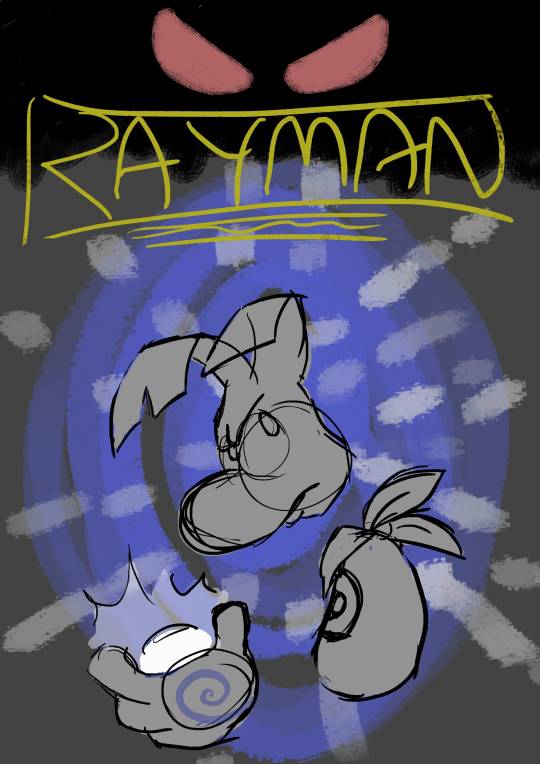
Cover sketch
When we weren’t playing Animal Crossing, Ikke and I had been working on a few little drawings and animations while together in the first lockdown in 2020. We were stuck in a flat together, Ikke was also in another country and I became really ill, so the story definitely had it's roots in feeling helpless and isolated. This wasn’t intended, but it’s obvious now that I’m looking back at the old notes...
(Some drawings in this post will be done by @ikkeforeal)
Please don't read ahead if you haven't read the story! (contains spoilers!)
< Start reading story here

Campsite sketch.
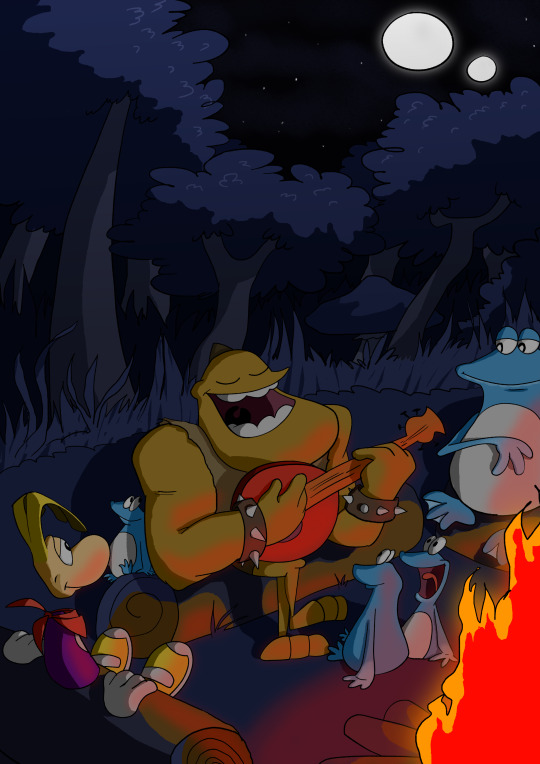
I originally wanted the first chapter's illustration to be based on this scene but it felt boring.
Rayman was originally going to be paranoid about Razorbeard getting away and having nightmares. He would come across a left over Robot Pirate head during a clean-up operation and look into the night sky, realising how little they knew about the outside world and where the Pirates even came from. This would make him feel small and helpless in protecting the Glade of Dreams.
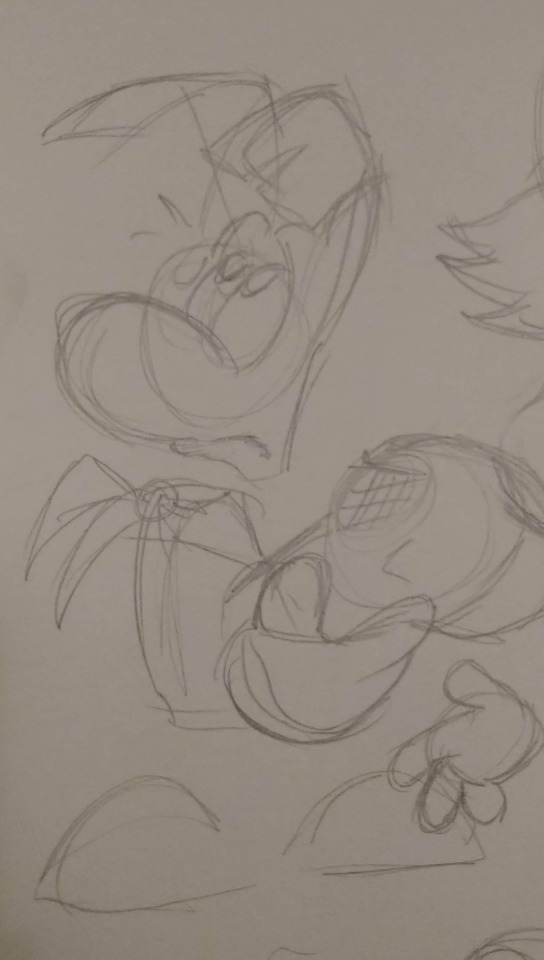

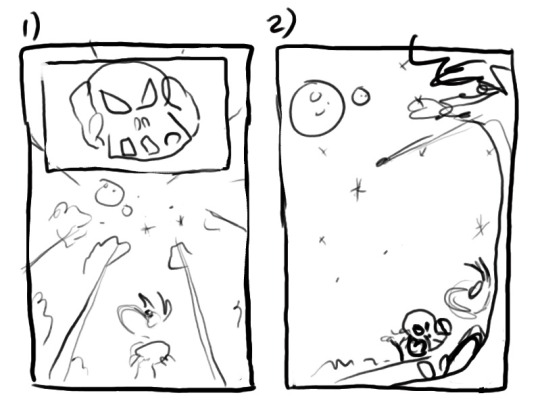
Rayman with Robot Pirate head.
This was eventually changed as it didn’t feel accurate to his character and instead became a dream that was planted in his head as a warning.
The character Morgan was originally going to be a bigger part of the story. She was someone that had been isolated from the rest of the world. A dark event happened that only she could recall, which was going to be a mysterious and all-consuming creature called The Hunger. Polokus had done a “windows reboot on the world” (as we called it) and paused time so then the mysterious creature was trapped and couldn’t continue. This was connected to him travelling to the Place where all the God’s meet to dream up a new future.
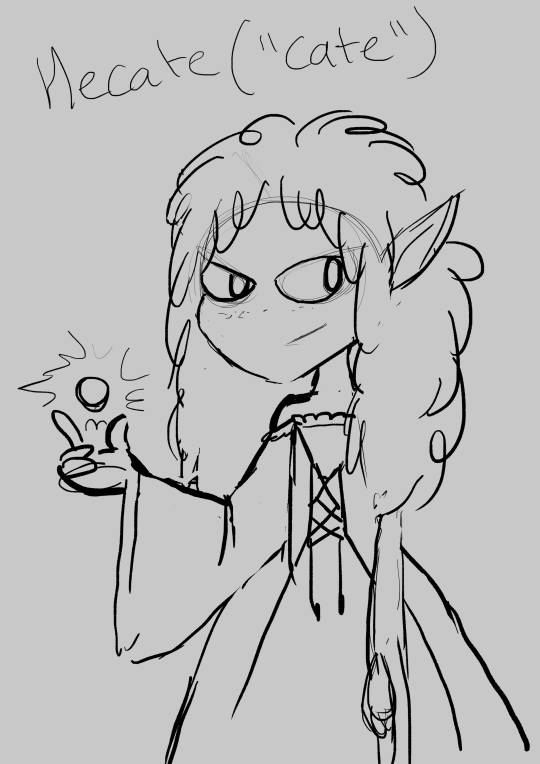

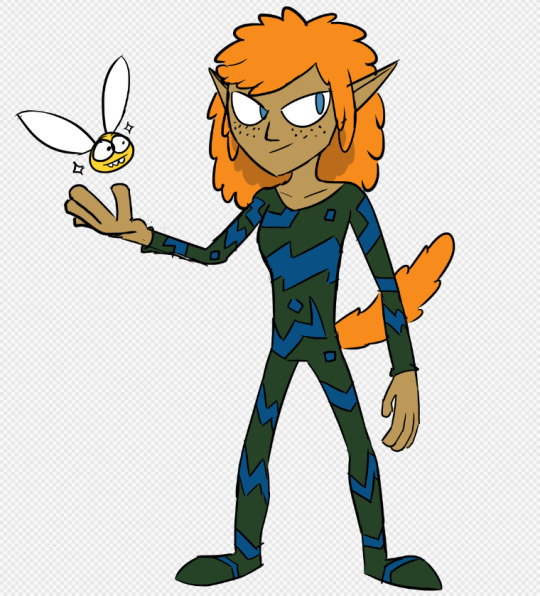
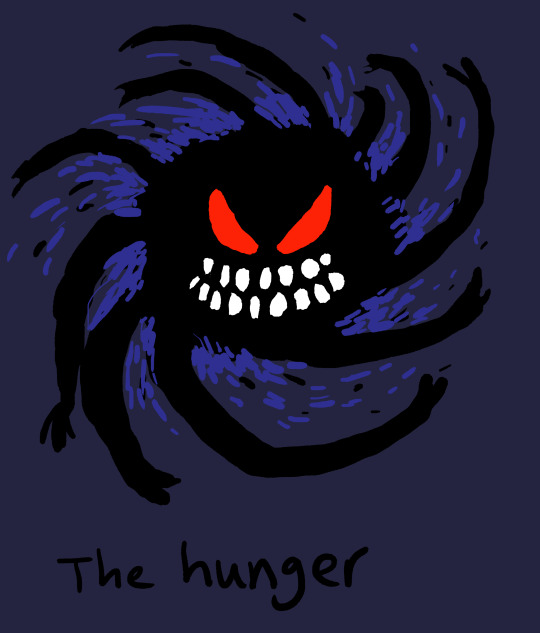
Morgan design and The Hunger.
Morgan was unhappy about the idea of the people not remembering the old world and wanted a real solution to defeating The Hunger.
Rayman was interested in gaining new powers so he could become stronger and Morgan needed him to fight new guardians and gather their masks for her. So she gave him the ability to create spiral doorways and to be able to travel anywhere he needed to be.
The reader was going to be lead in believing that Morgan was going to double-cross Rayman and have him summon The Hunger into the world instead using the masks.

A couple Mask designs.
When the story developed further, I realised that Morgan was going to have to be scrapped and replaced with the Muse of The Poets instead, especially so her connection to Polokus made more sense. This decision made us feel a bit sad because we really liked her as a character, so we decided to keep her as our own version of the Muse of the Poets instead.
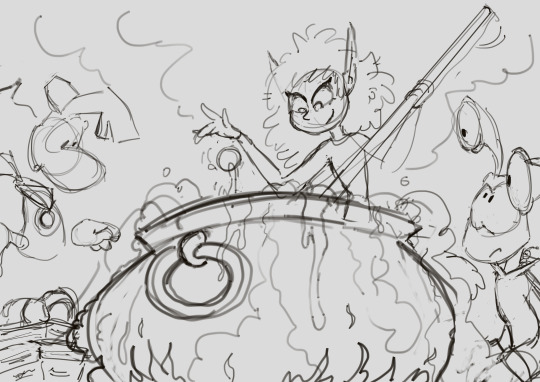
The sketch for Chapter 4's final illustration.
Getting Rayman into space was something that we were interested in as then he would be completely in unknown territory. But it was difficult to give him a reason *why* he should go into space and how. The original plan would be to have Rayman pilot an abandoned Pirate warship, but we didn’t want Rayman to be on his own. We decided it would be funny if we brought back Joe the alien from the first game, but also because then we could have a character that would be familiar with navigating space.

Joe the alien re-design. Wanted to give him a more "Rayman 2" look.
In 2021 I ended up deciding to take over the story just on my own since our living situation changed and our lives became busy again, but Ikke was still a big help.
I was stuck with what The Hunger was supposed to be. It didn’t make sense to have a character that had no motivation. If this story was going to be based around the events of Rayman 2, I realised that it could have a connection to the Robot Pirates in some way.
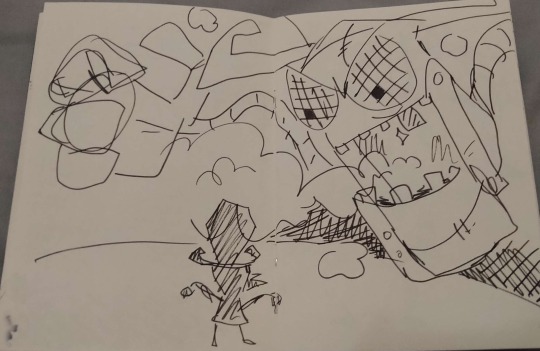
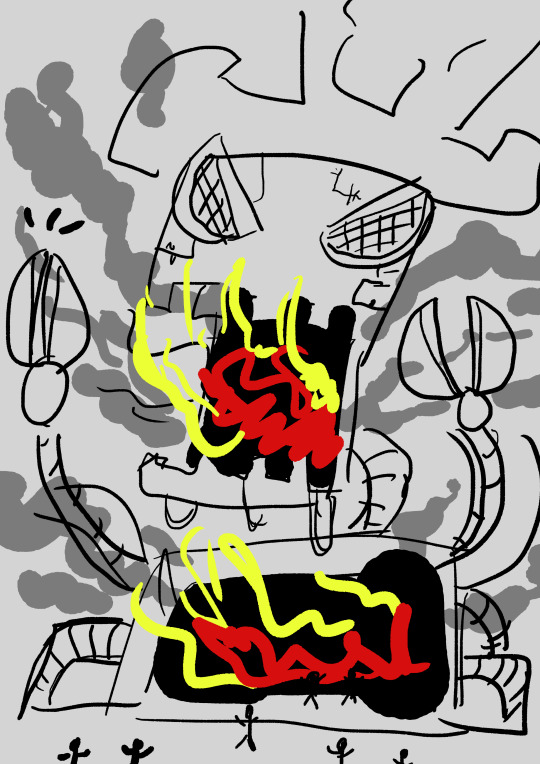
The Robot Pirate "Spirit" sketches.
I then had the idea that it could be the Robot Pirate God that was out for revenge on Polokus for wiping out the Pirates. I really liked this idea and ended up having to rewrite the whole story! (I think it worked out in the end though!)

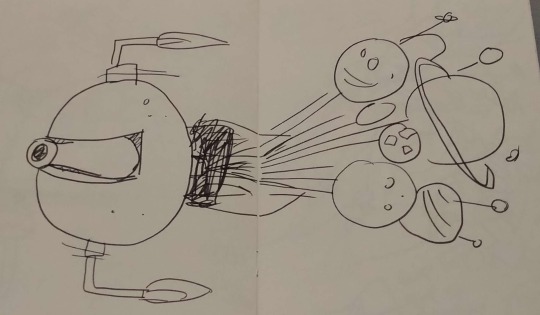
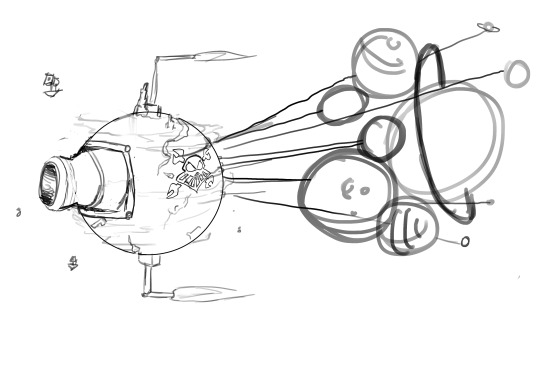
The Robot Pirate Planet doodles and chapter 3's final illustration sketch.
I could go on and on about every thought I had trying to piece the story together so it made sense but then we’d be here all day. I’m thankful for my friends who encouraged me to keep going.
I decided since the Robot Pirates were going to have a spirit, then that meant they needed their version of Jano. This made for a great idea for the twist in the story.



Robot God design and chapter 6's final illustration sketches.
Ultimately, I really wanted the story to be enjoyed by fans and also able to be read by anyone. I asked my flatmate who isn’t a Rayman fan to proof-read for me and her being able to understand what was going on gave me a lot of confidence for the story.
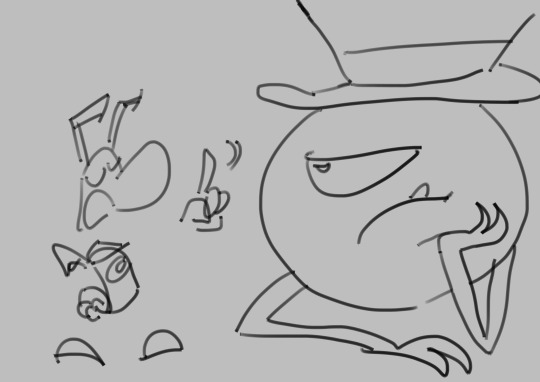
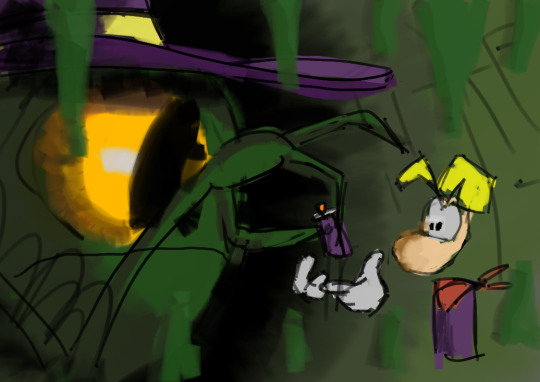

Sketches for chapter 2's final illustration.


Sketches for chapter 5's final illustration.
Murphy was originally going to be the narrator for the story. I really liked the idea of him being able to break the fourth wall and interact with the comic panels but I had to scrap him when it became a short story instead.

Murphy as a narrator.
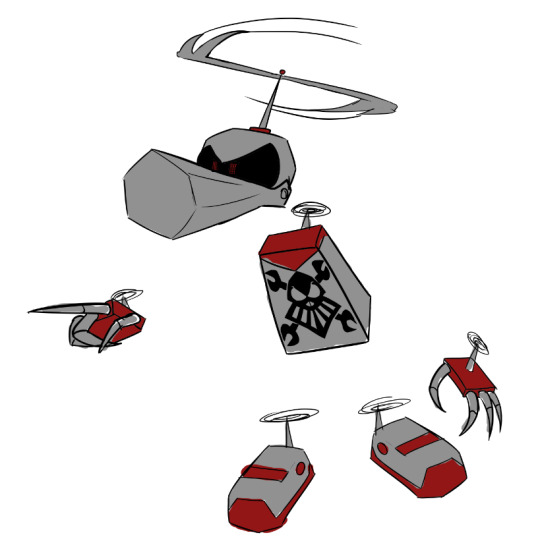
Robo-Rayman design.
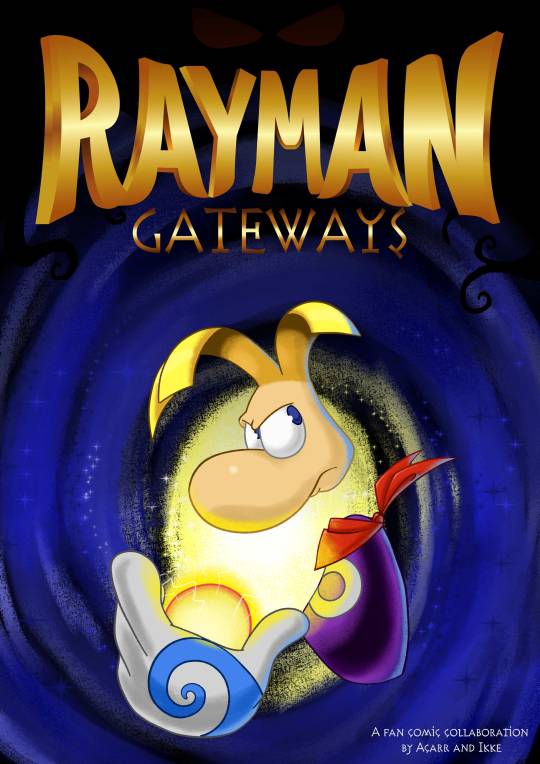
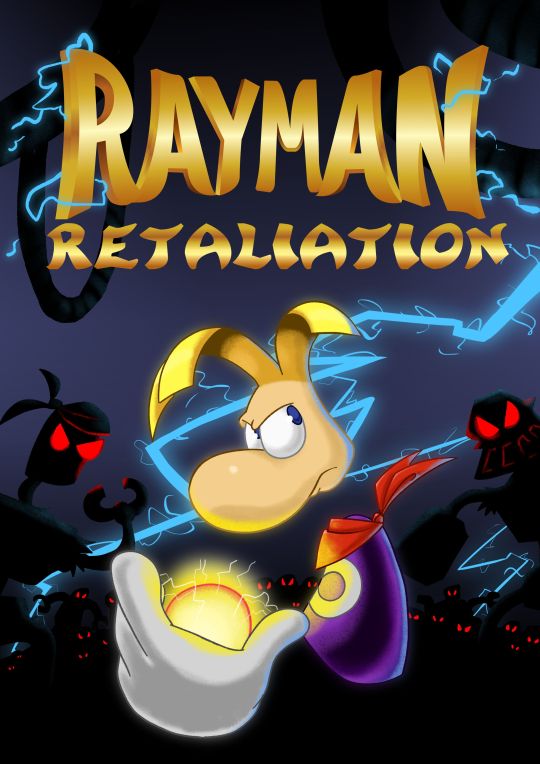
Old cover designs.
Dang only allowed 30 images per post? Well then. Guess that's all you're getting!!!! :')
Thanks for reading! I'm (probably) never writing a fanfic again, my fingers have crumbled into dust.
8 notes
·
View notes
Text
The tears of a clown
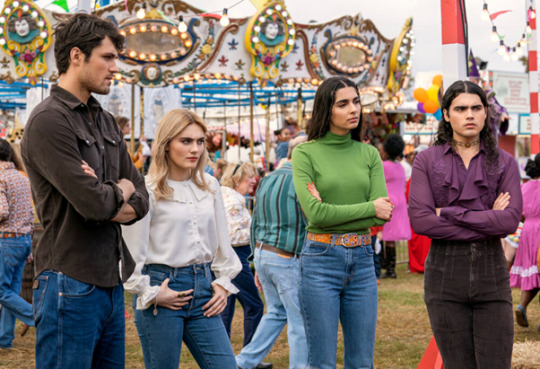
-Long, slow stare at the camera-
It had me in the first half, not gonna lie.
This show has such great MOMENTS. -frustrated screaming-
I’m liveblogging The Winchesters as a Supernatural!virgin. Please keep my lack of knowledge in mind if you continue...
In episode thoughts:
Yes, welcome back to the two-sentence horror stories! I love it!
Aww, Boy doesn’t want to Feel.
Also, adult Goosebumps again. Yessss.
Oh.
Oh no.
Oh, that clown is not okay.
This is doing a wonderful job of creeping me the hell out.
Also I cannot imagine the photography skill happening right now.
Oh, that was… d’yaghh. I'm so creeped out.
Mary, please just realise you’re dating an aggressive bastard. This is your life. This is what your life is gonna be like.
Ada’s back. Oh, I kind of wasn’t expecting that.
I love this bar. Can I go to this bar?
Wow, Carlos, what’s the attitude?
I am intrigued by how witches work in this series. I want to know more about this world, where they call themselves dark force users but consider growth to be a powerful magic. Trapping a demon in a plant is considered notable, but not powerful, and they’re staying outside of wars. I'm so intrigued.
Rowena seems like another Known Character. Is she known?
This circus is obsessed with jugglers. I've counted three so far.
Oh, come on, Carlos, you’re better at comforting people than this. But then, we haven’t actually seen enough of your relationship with Mary. Maybe this is really weird for you two, and I’ve just been making assumptions based on how you treat Latika.
Yeah, can we have more Mary and Carlos interactions? This is too late in the series for me to be asking for this, but can I have that please?
Ooh, an interesting story, of men who aren’t dealing with their emotions falling victim to a travelling troupe. I like it a lot.
Oh god damn it, John, you’re not entirely wrong about Mary, but you are being such a prat. Show, do not prove him right, I do not have the emotional time for this.
Oh god damn you show.
I want you to appreciate how immediately checked out I am with this turn of events.
I’d also like to see more of Carlos and Jonathan, actually. We occasionally get the tension from Carlos being lowkey protective of Mary and him knowing full well that John is bad for her, but it’s NEVER explored.
Ooh, witch fight!
…immediately disrupted by the story I AM CHECKED OUT OF.
…That’s not Mary. John is so bad at falling for these pretend people.
John, that is not your line. I do not for a second believe you give a single damn about the world.
So that was Mary. Show. Please show. This was such a great premise. Carlos is doing so good. Live up to your moments, show.
That is SUCH A GOOD concept, such a good discussion on depression and dealing with it, and how ‘cheer up, kid’ is NOT the solution, and goddamn it show, you have such good moments.
I like Rowena. I want more Rowena and Ada and this whole situation.
Show, you better bloody well make Mary go into why it was good.
Okay, this make up scene is good, but I do not approve of these two and you will never convince me this is a good relationship.
Yeah, okay, Mary runs away from her problems too, and this episode would have been fine for her to address that if it hadn’t been such a better theme to make it about John dealing with his emotions instead and I am so annoyed that they turned it on its heel after THAT argument specifically.
This show has a habit of introducing concepts, characters, and worlds that I am so invested in, and so curious about, and want to see more of, and then shoving them off to the side as unimportant. It’s honestly like this whole series is a pilot episode promising ideas and plans and concepts that it will go into if the show gets greenlit.
(or back to chapter one if you care.)
So basically, Mr Ackles, YOU’RE KILLING ME HERE. Okay. Last episode, friends, let’s go.
#the winchesters#this series is a pilot for a better longer series#show me how 'cheer up' kid is not helpful#show me how toxic masculinity hurts men#show me the witches and their world#show me Mary and Carlos being kickbutt hunters!#SLOW DOWN#MR ACKLES PLEASE
5 notes
·
View notes
Text
The Biological Sciences as a Career
The biological sciences are an excellent place to start whether you're considering career possibilities or have just begun your job hunt. The subject has many different professions, from research scientists to wildlife conservationists.
A bachelor's degree in biology, chemistry or a closely related discipline is often required for work in the biological sciences. Nevertheless, a master's or doctorate may be necessary for higher roles.
A research scientist designs and executes lab tests in a particular branch of biology. In a business or government organization, they may also help create products or procedures.
A bachelor's or master's degree in a specific subject, such as chemistry, computer science, environmental science, biology, or medicine, is usually required. They could also hold a Doctorate in the subject matter.
Some research scientists also have academic positions where they instruct future generations of scientists about a particular field of study and conduct studies.
Pharmaceuticals and medical research are two fields where research scientists are employed. The region and industry have an impact on these occupations' pay.
Medical researchers design and carry out experiments on illnesses and disorders to advance scientific understanding of issues relating to medicine and public health. Companies frequently use this research to create new medicines or healthcare items.
A bachelor's degree in a scientific discipline, such as chemistry, biology, or biomedical engineering, is required for those who want to work as medical researchers. Also, they must obtain expertise in research, grant writing, and laboratory work.
They generally then seek a Doctorate in a related branch of science. Students in these programs complete dissertations presented before a committee of experts, concentrating on laboratory work and original research.
Medical scientists can work in academic institutions or the business sector on research projects accepted by the employer after earning a Doctorate. They often need excellent oral and written communication abilities to communicate their results to doctors and other healthcare professionals.
To address issues with the production or usage of chemicals, fuels, pharmaceuticals, and food, chemical engineers employ the concepts of chemistry, biology, physics, and arithmetic. They are employed in manufacturing facilities, research labs, and pilot plant establishments.
Chemical engineering is the area of engineering that develops machinery, methods, and procedures for blending, compounding, and processing chemicals to create valuable products from raw materials. The fundamental concepts include material and energy balances, thermodynamics, fluid mechanics, separation technologies, and chemical reactor design.
Chemical engineers have a wide range of career options and can choose to work in various sectors. Examples include the production of ammonium nitrate at a fertilizer plant, converting crude oil into gasoline, jet fuel, diesel fuel, and lubricating oil in a petroleum refinery, or blending several chemicals to create shampoo or body lotion at a personal care product maker.
Biomedical engineers create and develop devices that aid doctors in patient diagnosis and treatment. Examples include medical imaging equipment and tools that enable remote medication or surgical patient treatment.
The discipline of biomedical engineering is ever-evolving, making it a great fit for those who appreciate the challenge of developing novel solutions to new issues. These advancements immediately enhance the health and quality of life of patients.
Work environments for biomedical engineers include hospitals, research centers, educational institutions, and governmental organizations. They create brand-new gadgets, evaluate their performance, and offer technical assistance for already-available goods.
3 notes
·
View notes
Text
no one is replacing trees with tanks of "green slime" lmfao. this is meant as a solution in extremely dense urban areas where planting more trees and creating more green space is either extremely difficult or literally impossible. such as in belgrade, where this project was piloted.

^that doesn't look like replacing trees to me!
that "green slime" can sequester more carbon dioxide than a single tree in a fraction of the time it would take that tree to grow, by the way. and the algae biomass created by this process is valuable as fertilizer, biofuels, and a bunch of other things we can use (source)! so give green slime in a glass tank a chance!
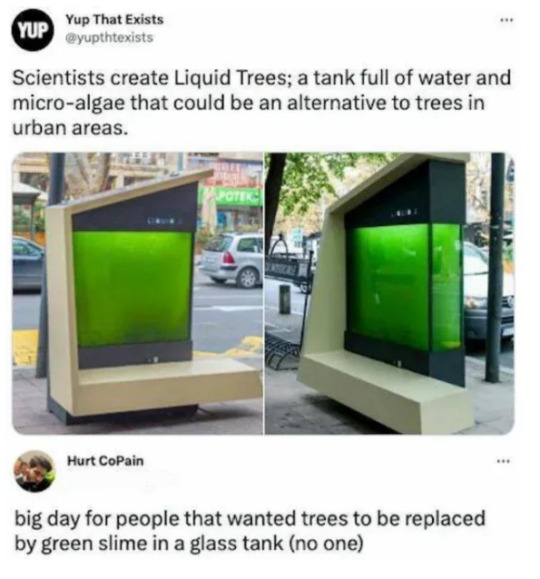
#leo rambles#SORRY TO GET AGGRO ON YOUR REBLOG NOX IT'S NOT @ YOU#this shit's just important to me and it irritates me when people balk at environmental mitigation strategies that aren't just#'uwu return the land to its pristine state'#everyone loves ecofuturism and 'solarpunk' until someone suggests solutions weirder than 'plant some trees'#NOT EVEN MENTIONING THAT THIS IS ALSO A BENCH. BTW. SOMETHING URBAN AREAS NEED MORE OF
129K notes
·
View notes